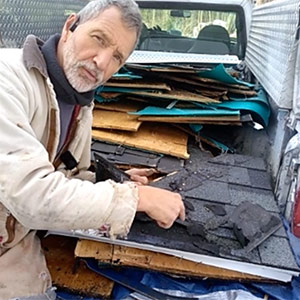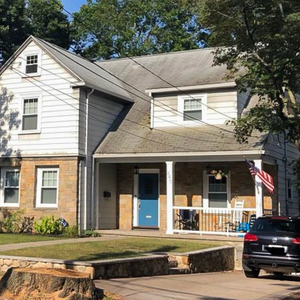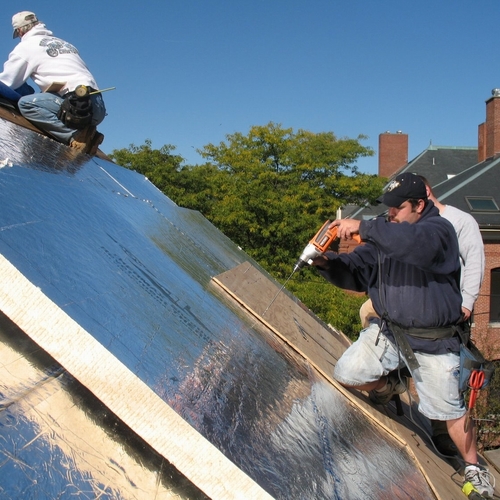
Builders once had one choice when it came to roofing underlayment: asphalt-saturated felt. OK, two choices—#15 asphalt felt and #30 asphalt felt. These days, there are dozens of brands of synthetic underlayment to choose from; products that cost more but also outperform the old standbys in many ways.
Felt paper remains the only type of underlayment that is explicitly mentioned in the International Residential Code (IRC), but plastic underlayments are widely accepted and have largely taken over the residential market, according to industry experts. Generally speaking, they are lighter, less prone to tearing and wrinkling, and more resistant to UV damage than felt paper.
Synthetic underlayments are typically made from polyethylene or polypropylene plastic and come in two basic types—vapor open and vapor impermeable. Impermeable underlayments far outweigh the number of vapor-permeable products, and they are the less expensive of the two, as Martin Holladay found in this survey published in Fine Homebuilding magazine. As building assemblies become tighter and better insulated, and the risk of moisture damage rises, vapor permeability may be an issue worth considering. Warranties offered by roofing manufacturers also may steer builders in deciding which underlayment to use.
Roofing underlayments shouldn’t be confused with peel-and-stick membranes like Grace Ice & Water Shield. These waterproofing products are typically used along the eaves, as a hedge against damage from ice dams, in valleys, and in other high-risk areas—where a dormer wall meets the roof, for example. In coastal areas where wind-driven rain is a bigger risk, some builders completely cover sheathing from eave to ridge with peel-and-stick membranes instead of an underlayment. Still, these self-adhering membranes are really a different category of building product. (The Asphalt Roofing Manufacturing Association has published a guide on the use of self-adhering membranes, which you can read here.)
Weekly Newsletter
Get building science and energy efficiency advice, plus special offers, in your inbox.

This article is only available to GBA Prime Members
Sign up for a free trial and get instant access to this article as well as GBA’s complete library of premium articles and construction details.
Start Free TrialAlready a member? Log in















14 Comments
"A different scenario is when the roof assembly (from the inside) consists of structural sheathing, underlayment, furring strips, nail base, and asphalt shingles."
If, by nailbase, you mean sheathing bonded to rigid foam, why would that ever be installed over furring strips? What good would the foam do if decoupled from the structural sheathing?
I really like the roof assembly described by John Abrams in his Jan 2011 article in JLC, "High-Performance Homes on a Budget". The assembly is simple, 14 inch I-joists dense packed with cellulose with the structural roof sheathing (ZIP System) taped to the exterior wall sheathing. I especially like the applied overhang detail provided in the article.
https://www.jlconline.com/how-to/insulation/high-performance-homes-on-a-budget_o
In my case (4B, mixed-dry) I'd add rigid foam above the structural roof sheathing to meet code. I like the idea of nailbase panels to keep the sheathing warm AND to protect the rigid air barrier during future reroof work. But I do not see where furring strips would make sense in this assembly.
Hi Aaron.
I believe that in this case, the "nail base" Scott is referring to is another layer of sheathing use as a nailer for the asphalt shingles. I'm going to check with Scott and clarify the article if I am correct.
Brian is correct, and I've clarified the article. Thanks for pointing this out, Aaron.
Thank you for the article; it presents a lot of valid points. The main issue I find is that there are so many situations with roofs that there isn't a one-size fits all underlayment answer. I own a small roofing company in northern NY and I am currently building my own home. I am planning a different roofing solution than any other home I have ever worked on. Why? Because I am doing a totally different style of building.
My new home with be using SIP's for the walls and roof and be completely open inside. As many know, SIP's have a storied past involving moisture issues from improper sealing inside, leading to rot near the peak of the exterior OSB sheathing. A common solution to this, is covering the roof with a vapor permeable underlayment, then installing vertical furring strips and a 2nd layer of sheathing. Over the 2nd layer, a non-permeable layer can be used, something like Grace I&W, and then shingles. The requirement is that ventilation strips are used at the eaves and peaks of the roof to allow the house to breathe out any moisture that made it through the roof SIP.
It is a lot of extra work, and maybe unnecessary if you did your air-sealing correctly and have a properly functioning ERV or HRV to keep humidity at normal levels inside. However, is it worth the risk? If there is moisture and it is getting through, do you want your SIPs to start to rot? Once they are compromised, there is no easy way to repair them since they are structural.
So, after all of this, which most people on here are already aware of, I have a question involving underlayment for the roof panels. I have been considering which type of underlayment to use, and fully understand that nails and/or staples do create thousands of holes, and those are just to keep the stuff from blowing off/falling off while you walk on it. After that you nail furring strips through it, or on a regular roof, install shingles or metal over it. In my experiences, synthetic underlayments do leak, though a very small amount, through staples and nails. So why not find a way to prevent this problem using products that have already solved this for other parts of the house?
For my walls, I will be using GCP Technologies (formerly Grace) Vycor ENV-S as the water-resistive barrier. It is vapor-permeable, water-proof, and most importantly, self-adhered. The other great factor about ENV-S is that is does seal around nails and staples. So, why not use regular ice & water barrier at eaves and valleys, as usual, but then self-adhere the ENV-S product on the rest of the roof? Then, when I install the furring strips over top, it will seal around those nail holes. This will allow my SIPs to breathe and keep any condensation or rain out (during construction) without having thousands of staple or nails holes. Then, I can cover the furring with a layer of sheathing and then whatever I want after that, including a non-permeable ice & water over the whole roof deck if I want to really be confident it will never leak.
So, are there issues with using something like Grace Vycor ENV-S as an underlayment? I realize the cost is high, but I am only doing it once and living in this house for the next 50-60 years (hopefully!). I never had the thought of doing this, despite years of roofing and reading hundreds of articles about roofing underlayments. I am curious what feedback anyone might have about it.
Thank you,
Nick
Nick,
I have no experience around SIPs so you should take that into account when reading my comments.
The worries around leaks at fastener penetrations are why all the roof underlayments I've used specify in their installation guides that cap-fasteners have to be used, not nails or staples.
- Vycore ENV-S does not appear to be approved as a roof underlayment.
- If the worry is air-sealing, why not use a fully-adhered non-permeable membrane over the whole roof area?
That is the issue, it has to be a permeable layer directly on the SIP roof, because moisture that can possibly come out of the house has to have a place to escape. If it hits a non-breathable layer, it will condense in the outer layer of the SIP and cause it to rot. Air-sealing is not the issue I am trying to solve, it is having a good, breathable layer that can be installed without having all of the staples and nails. Cap nails are a good option for this situation, as it would be covered by furring strips. Cap nails are not an option if you are doing metal roofing directly over, because they will show through.
I agree ENV-S is not an approved roof underlayment, but in this case it isn't really doing anything much differently than my walls with a rainscreen over the top. Since it isn't having shingles or metal applied directly to it, then it isn't really a roofing underlayment if looked at that way. It is more or less a WRB for the roof, below the raised, 2nd roof deck.
Nick
Nick,
Approval aside, The ENV-S sounds like a good choice. I agree it isn't really being used as a roof underlayment as we usually think of one.
A bit of an aside, but your comment on cap-nails hit h0me for me. I've had them telegraph though metal roofing too, but no one talks about it and that's what is supposed to be used. I still prefer staples for that reason.
good luck with your build!
Nick,
I also have not built with SIPs, but have been aware of the condensation issues for some time. So with that caveat....
Why use any membrane at all on top of the SIPs? Why not just air-seal the joints in the SIPS and leave the OSB exposed to the air cavity created by the furring strips. The OSB itself is a variable permeability membrane. With a full layer of ice&water on top of the nailbase, you shouldn't get any bulk water into the cavity and even if you did, it can dry by ventilation. I don't see any real value to using any type of underlayment below the cavity.
Peter,
That's a good point - and one that completely eluded me. The cavity is similar to any other one below sheathing, and we don't use membranes on any of them.
I am not sure why I wasn't getting notifications that there were replies to this, sorry for the delay!
The idea of having no underlayment seems like it should work in theory, but it would almost feel wrong to have nothing there. Perhaps the ENV-S is overkill in that instance, and a stapled on synthetic underlayment would be fine. Then, furring strips and a 2nd layer of decking with a quality, non-permeable ice & water barrier on all of it would nearly ensure that any small amount of leaked water wouldn't get through.
Still thinking about this...will be meeting up later this week with the company that designs and builds the timber-frames and works with the SIPs. I will pick their brains on it some more.
Since metal roofing readily transfers heat is it a good idea to use synthetic underlayment for metal roofing in areas that experience wild fires? If a hot brand lands on the roof I would think the synthetic would easily melt in that spot.
David,
One of the reasons most metal roof manufacturers require synthetic underlayment was that roofing felt can melt just from the heat on sunny days. They may both experience damage in a wildfire, but of the two, synthetics are probably the safer bet.
While there is no ASTM standard for testing synthetic underlayments there is an ICC Acceptance Criteria - #188 - that manufacturers of synthetics have their products tested under. It seems that building officials look for that test approval when accepting a synthetic as an alternative to asphalt underlayment.
There are many manufactured products we use regularly that don't have an IRC / ICC listed ASTM standard which they must meet to qualify as being 'code compliant.' The local building department has broad authority to 'approve' our use of these newer products.
Thanks for the comment Mike. It jibes with what Glenn Mathewson recently explained to me. When the IRC uses the word "approved," it means approved by the local building department, not necessarily by the IRC or even the ICC-ES.
Log in or become a member to post a comment.
Sign up Log in